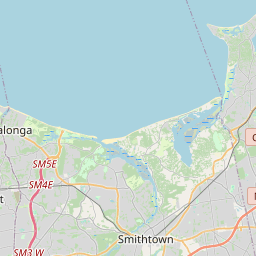The Osterby House
Historical marker location:
1063 Fort Salonga Road, Fort Salonga, New York
( Marker is on Fort Salonga Road (New York State Route 25A) east of Makamah Road, on the left when traveling east.)
Marker installed: 2011







© OpenStreetMap contributors
Loading...
Searching for other points of interest within 3 miles of this location.The Woodstock Music Festival, which is considered a seminal moment in American cultural history, did not actually take place in the town of Woodstock, New York. The festival was held on a dairy farm in nearby Bethel, New York, about 60 miles south of Woodstock.
About Suffolk County
Suffolk County Timeline
Suffolk County, located on Long Island in New York, has a rich and diverse history dating back to the early colonial era. The first European settlers arrived in the 17th century, with the Dutch establishing trading posts and the English later taking control of the region. The area was home to Native American tribes, notably the Shinnecock and Montaukett peoples, who were gradually displaced as European settlements expanded.
During the American Revolutionary War, Suffolk County played a significant role. The county saw numerous battles and skirmishes, and the region served as a base for both American and British forces. After the war, the county experienced rapid growth as agriculture and maritime trade flourished. The early 19th century witnessed the rise of shipbuilding, fishing, and whaling industries, with towns like Greenport and Sag Harbor becoming significant maritime hubs.
In the mid-19th century, the construction and expansion of railroads transformed Suffolk County into a popular summer resort destination for wealthy New York City residents. The opening of the Long Island Rail Road in 1844 allowed for easier access to the county's picturesque beaches and rural countryside. This era also marked the growth of suburban development, as more people sought to settle in Suffolk County and commute to the city.
In recent decades, Suffolk County has undergone further development and diversification. The region's economy has expanded beyond agriculture and maritime industries, with a focus on sectors such as healthcare, education, technology, and tourism. The county also faces challenges such as population growth, transportation issues, and environmental concerns, particularly regarding coastal erosion and water quality. Overall, Suffolk County remains an important part of Long Island's history, boasting a vibrant past and a thriving present.
During the American Revolutionary War, Suffolk County played a significant role. The county saw numerous battles and skirmishes, and the region served as a base for both American and British forces. After the war, the county experienced rapid growth as agriculture and maritime trade flourished. The early 19th century witnessed the rise of shipbuilding, fishing, and whaling industries, with towns like Greenport and Sag Harbor becoming significant maritime hubs.
In the mid-19th century, the construction and expansion of railroads transformed Suffolk County into a popular summer resort destination for wealthy New York City residents. The opening of the Long Island Rail Road in 1844 allowed for easier access to the county's picturesque beaches and rural countryside. This era also marked the growth of suburban development, as more people sought to settle in Suffolk County and commute to the city.
In recent decades, Suffolk County has undergone further development and diversification. The region's economy has expanded beyond agriculture and maritime industries, with a focus on sectors such as healthcare, education, technology, and tourism. The county also faces challenges such as population growth, transportation issues, and environmental concerns, particularly regarding coastal erosion and water quality. Overall, Suffolk County remains an important part of Long Island's history, boasting a vibrant past and a thriving present.
Suffolk County Timeline
This timeline provides a concise overview of the key events in the history of Suffolk County, New York.
- 1640 - English settlers from New Haven, Connecticut, purchase land from local Native Americans and establish the first permanent European settlements in Suffolk County.
- 1683 - Suffolk County is officially formed as one of the twelve original counties of the Province of New York.
- 1692 - Witch trials occur in the town of East Hampton, resulting in the execution of three women accused of practicing witchcraft.
- 1792 - Suffolk County splits into two separate counties: Suffolk County and Queens County.
- 1812 - The War of 1812 begins, leading to a wave of British attacks on Suffolk County's coastal towns and shipping industries.
- 1868 - The Long Island Rail Road expands into Suffolk County, connecting it to New York City and spurring population growth and economic development.
- 1898 - Suffolk County's population reaches 150,000, with agriculture, fishing, and tourism as its primary industries.
- 1938 - The "Long Island Express" hurricane devastates Suffolk County, causing widespread destruction and loss of life.
- 1963 - Suffolk County Community College is established, providing accessible higher education to local residents.
- 1978 - The notorious "Son of Sam" serial killer, David Berkowitz, is arrested in Suffolk County.
- 1997 - Suffolk County approves the preservation of 10,000 acres of open space, protecting the region's natural resources and scenic beauty.